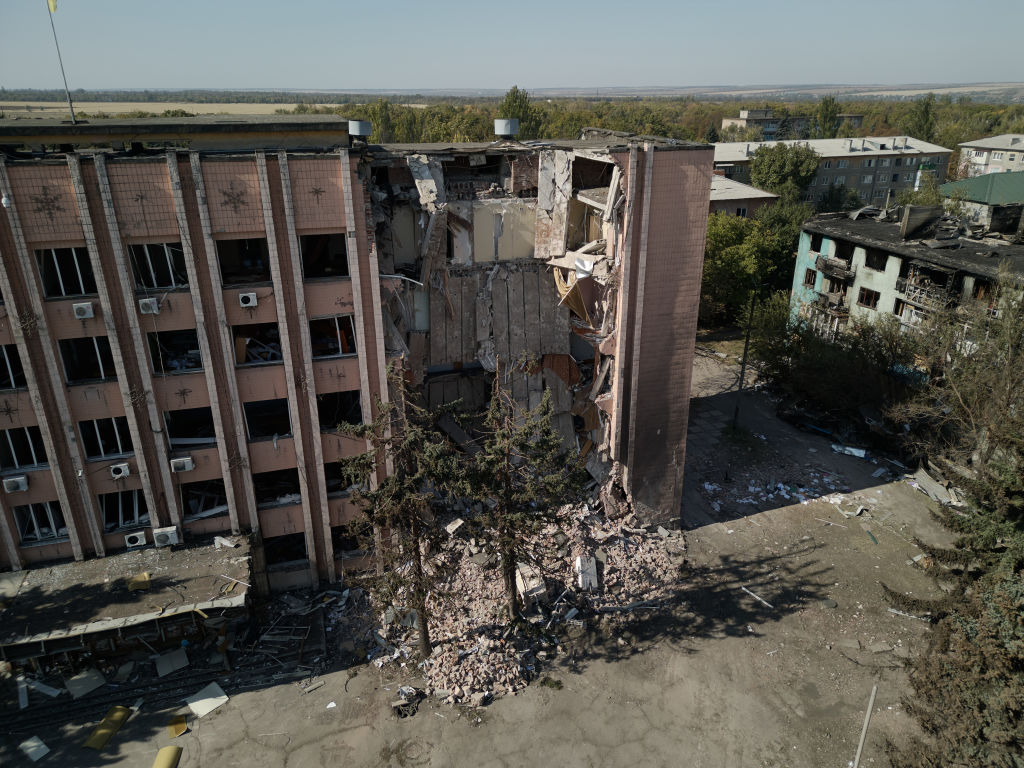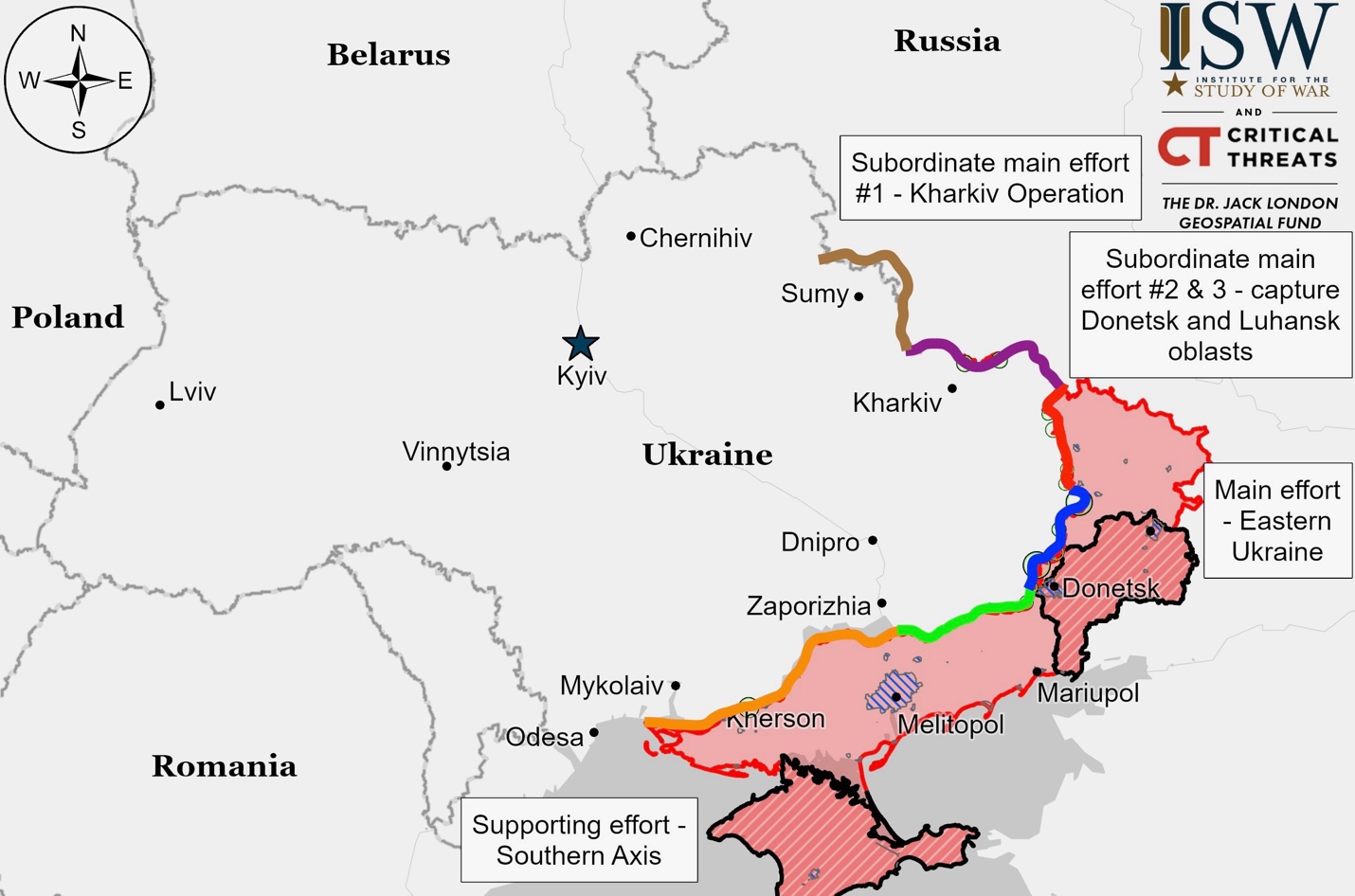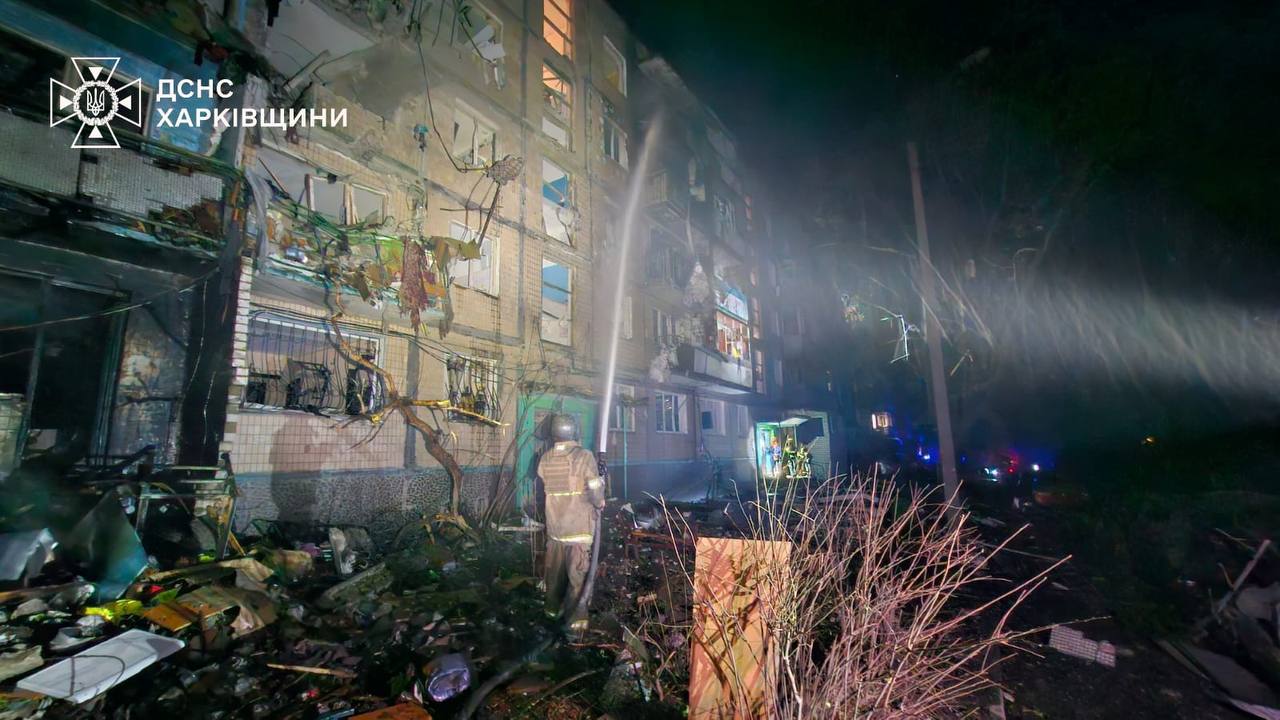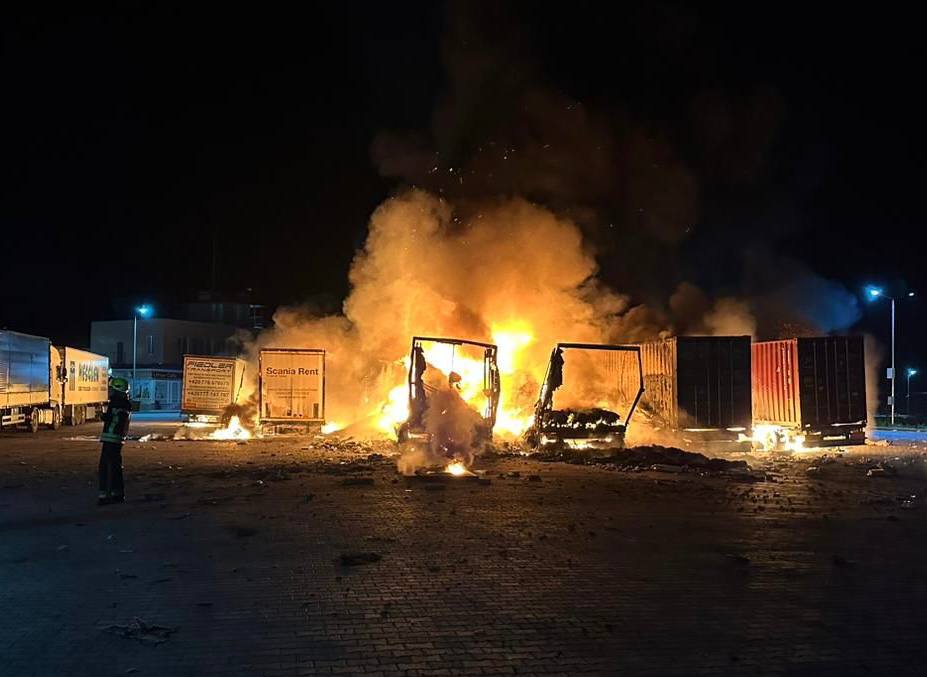Summary of the Day:
Russian forces have recently made marginal advances near Svatove, Siversk, Vuhledar, and east and southeast of Pokrovsk. Both Russian and Ukrainian forces continue to conduct assaults in Kursk Oblast. The situation remains fluid along these fronts as both sides attempt to gain tactical advantages.
Ukraine is intensifying efforts to expand its domestic production of military equipment, with a focus on maintaining its drone advantage over Russia. President Zelensky announced that Ukrainian companies can produce 4 million drones annually, outpacing Russia’s planned production. Ukraine is also increasing production of artillery systems and has successfully tested a domestically produced ballistic missile.
In response to a recent Russian drone crash in Latvia’s Rezekne municipality, Latvian forces have enhanced air defenses near the Russian border. The Latvian Air Force has deployed mobile combat groups with air defense missiles in Latgale and installed specialized radars along the border to detect drones.
Russian defense enterprises are actively recruiting tens of thousands of new workers to address acute personnel shortages. This recruitment drive comes as Russia increases weapons production to support its ongoing war efforts in Ukraine.
Picture of the Day:
 The exterior of an administration building that was bombed by Russian forces in Dobropillia near Pokrovsk in Donetsk Oblast. Russian forces are advancing toward Pokrovsk. (Pierre Crom/Getty Images)
The exterior of an administration building that was bombed by Russian forces in Dobropillia near Pokrovsk in Donetsk Oblast. Russian forces are advancing toward Pokrovsk. (Pierre Crom/Getty Images)
Beyond Ukraine – The March Towards World War
NATO faces significant readiness challenges for potential large-scale conflict with Russia, according to retired U.S. Lt. Gen. Ben Hodges. Speaking at the Warsaw Security Forum, he highlighted inadequate air defenses, military mobility, ammunition, and mindset among NATO forces. Hodges warned that Russia could quickly strike European transport infrastructure, leaving cities like Gdansk, Klaipeda, Tallinn, and Bremerhaven vulnerable. He emphasized the need for faster deployment capabilities, increased ammunition production, and more decisive leadership to address these vulnerabilities and improve NATO’s overall preparedness.
Russian Deputy Foreign Minister Mikhail Bogdanov met with Lebanon’s ambassador to Russia, condemning Israel’s ground operation in southern Lebanon. Bogdanov emphasized Russia’s opposition to alleged Israeli political assassinations and stressed the importance of humanitarian aid to Lebanon. Russian officials, including Ambassador to Israel Anatoly Viktorov and Foreign Minister Sergei Lavrov, called for an immediate end to the Middle East conflict. Russia has invited Palestinian Authority President Mahmoud Abbas to the upcoming BRICS summit in Kazan, where the situation in the Middle East will be discussed. The Russian Foreign Ministry also criticized Israel’s actions against Hezbollah and Iran.
Russian Deputy Foreign Minister Alexander Grushko, in a September 30 interview, accused Latvia, Lithuania, and Estonia of being hostile to Russia and supporting Nazism. He claimed these countries sacrificed their sovereignty to NATO, which would use them as a buffer against Russia. This rhetoric, similar to justifications used for invading Ukraine, may be intended to intimidate Baltic states from opposing Russian interests in Europe.
Latvia has strengthened its air defense near the Russian border after a Russian drone crashed in the country on September 7. The Latvian Air Force has deployed mobile combat groups with air defense missiles in Latgale and installed specialized radars along the border to detect drones. Both professional military personnel and members of the National Defense Service are involved in this operation.
The Russian Ministry of Defense reported that Russian peacekeepers, along with Kazakh, Kyrgyz, and Tajik forces, conducted a joint military exercise in Almaty, Kazakhstan. The “Indestructible Brotherhood-2024” drill simulated repelling an attack on a border checkpoint, incorporating drone reconnaissance and detaining mock enemies. This exercise likely draws from Russia’s combat experience in Ukraine.
Situation On The Land, Sea, and Air in Ukraine
A Russian military blogger suggested on October 2 that increasing drone operators on the frontline would be more effective than mass infantry deployments. This approach could reduce reliance on costly ground assaults that yield minimal gains. However, the blogger noted that new infantry is still needed due to Ukraine’s tech advantages, urban combat needs, and rotation requirements. The recent reassignment of drone specialists to infantry roles, resulting in their deaths, has angered Russian ultranationalists.
A pro-Kremlin military blogger, Yegor Guzenko, reported on Monday that Russian forces are facing artillery ammunition shortages across the front, particularly in areas of active assault operations. He attributed this to recent Ukrainian drone attacks on ammunition depots in Toropets and Tikhoretsk. Guzenko claimed the shortage is worsening, with some units facing rationing and being forced to attack without artillery support. He questioned where newly produced ammunition was going, implying potential mismanagement or misconduct among Russian commanders. This follows Guzenko’s earlier criticism of Russian leadership, including President Putin, which he has since deleted.

Ukrainian Operations in the Russian Federation – Initiative None
Ukrainian forces attacked in Kursk Oblast but made no confirmed progress. Russia claims it stopped Ukrainian attacks near Olgovka, Cherkasskoye Porechnoye, and Plekhovo. The fighting centered around the towns of Korenevo and Sudzha.
Ukrainian forces attacked in Glushkovsky Raion but made no confirmed progress. A Russian source claimed Ukrainians briefly reached Veseloye’s outskirts on October 1 before being pushed back. Russia reports repelling attacks near Veseloye, Novy Put, and Obukhovka, with ongoing fighting and a Russian counterattack near Novy Put.
Russian forces attacked in Kursk Oblast without confirmed gains. A Russian source claimed they retook Novosyolovka and advanced near Plekhovo. Russia reports attacks near Lyubimovka, Nikolayevo-Darino, Novosyolovka, and Plekhovo. Russian naval and airborne units are reportedly active in the area, including near Apanasovka.
Kharkiv Front – Initiative Russia
Russian forces attacked north and northeast of Kharkiv City with no confirmed frontline changes. They claimed to capture Starytsya and part of a forest near Zelene, but this is unconfirmed. Attacks occurred near Starytsya and Vovchansk. Russia reportedly struck Vovchansk with a glide bomb, though the type is disputed.
Luhansk Front – Initiative Russia
Russian forces advanced near Novovodyane, southwest of Svatove. They claim to have captured Makiivka and are moving toward Rubtsi, though this is unconfirmed. Attacks continued along the Kupyansk-Svatove-Kreminna line, including near Synkivka, Novoosynove, Andriivka, Hrekivka, Torske, and in the Serebryanske forest area.
Donetsk Front – Initiative Russia
Siversk
Russian forces made a small advance near Siversk, pushing north of Spirne. Claims of capturing Verkhnokamyanske remain unconfirmed.
Chasiv Yar
Russian forces continued attacks near Chasiv Yar, targeting surrounding areas including Hryhorivka, Mayske, Markove, Ivanivske, Andriivka, Klishchiivka, Bila Hora, and Stupochky. No confirmed frontline changes were reported.
Toretsk
Russian forces continued attacks near Toretsk, including assaults on Toretsk itself, Nelipivka to the south, and towards Shcherbynivka to the southwest. Some Russian sources claimed a small advance in central Toretsk, but this remains unconfirmed. No verified changes to the frontline were reported.
Pokrovsk
Russian forces made small advances east and southeast of Pokrovsk. They reportedly gained ground near Hrodivka and Tsukuryne. Attacks continued in several nearby settlements, including Vozdvyzhenka, Novotoretske, and Selydove. Some sources claimed advances near Selydove and Nevelske, but these remain unconfirmed. Ukrainian drone activity is reportedly hindering further Russian progress in some areas.
A video released on Telegram on October 1 shows Russian forces executing 16 Ukrainian prisoners of war in the Pokrovsk district of eastern Ukraine. The footage, captured by a Russian drone, depicts Ukrainian soldiers surrendering and being deliberately shot after lining up. Ukraine’s Prosecutor General Andriy Kostin called this the largest reported case of Ukrainian POW execution on the front line, emphasizing it as part of a deliberate Russian policy. The incident, which violates the Geneva Conventions, is under investigation by Ukrainian authorities. This comes shortly after a UN commission reported widespread torture of Ukrainian civilians and POWs by Russian forces in occupied territories and Russia.
West of Donetsk City
Russian forces continued attacks west of Donetsk City near Heorhiivka and Kurakhove. A Russian source claimed an advance in Maksymilyanivka, but this remains unconfirmed. No verified changes to the frontline were reported in this area.
Southwest of Donetsk City
Russian forces have captured Vuhledar, a strategically important town located 50 km southwest of occupied Donetsk in Donetsk Oblast, after nearly two years of Ukrainian defense. The Ukrainian military authorized a withdrawal to preserve personnel and equipment as Russian forces threatened to encircle the town. Vuhledar’s significance stems from its proximity to critical roads and its status as the last fortified town before Velyka Novosilka, making its loss potentially impactful for Ukraine’s defense of southern Donetsk Oblast. Russian forces also made small advances northwest of Vuhledar along the Pavlivka-Bohoiavlenka road and continued attacks near Kostyantynivka, Katerynivka, and Bohoiavlenka.
Zaporizhia Front – Initiative Russia
Zaporizhia-Donetsk Border Area
No fighting was reported in the Donetsk-Zaporizhia border area. Russian forces are allegedly consolidating positions near Staromayorske for future operations.
Zaporizhia Line
Russian and Ukrainian forces engaged in ongoing battles near Novodanylivka, Mali Shcherbaky, and Kamyanske in western Zaporizhia Oblast. The frontline remained unchanged.
Kherson (Dnipro River) Front – Initiative Russia
The Ukrainian General Staff reported that Russian forces did not launch any offensive operations in the Kherson area.
Ukraine News
Russia launched 32 Shahed drones at Ukraine from Primorsko-Akhtarsk and Kursk. Ukrainian forces shot down 11 drones over Kirovohrad, Odesa, and Sumy regions, while electronic warfare caused 10 others to miss targets. Russian forces also struck Kharkiv City, Derhachy, and Cherkaska Lozova with glide bombs, damaging infrastructure. In Odesa region, drones hit port facilities in Izmail district.
Kherson, a city in southern Ukraine, is facing relentless attacks from Russian kamikaze drones targeting civilians. These modified commercial drones, often loaded with grenades or explosives, are being used to “hunt” people in what locals call a “human safari.” The attacks have intensified, with up to 330 strikes reported in a single day. Residents of Kherson, Antonivka, and Sadove are struggling to maintain normal life amid the constant threat. The drones not only kill and injure civilians but also damage critical infrastructure, including hospitals and water supplies. Ukrainian forces are working to counter these attacks, but the Russian military’s frequent changes in drone frequencies make defense challenging. Despite the danger, many residents remain in the city, which has seen its population drop from 280,000 to about 60,000 since the start of Russia’s full-scale invasion.
Ukraine is discussing with the International Atomic Energy Agency (IAEA) about placing foreign observers near its nuclear power plants due to concerns about potential Russian attacks on related energy infrastructure. President Zelensky has warned of planned strikes on three power plants. The operating nuclear facilities in Ukraine are in Rivne, Khmelnytskyi, and Pivdennoukrainsk. The Energy Ministry suggests that Russia might target substations connected to these plants. Ukraine lacks sufficient air defense systems to fully protect against ballistic missile attacks on energy facilities. The country is seeking international support to safeguard its nuclear and energy stability as it prepares for potential winter blackouts.
Ukraine’s State Border Guard Service reported the temporary closure of the Orlivka ferry crossing to Romania due to Russian attacks. Russian forces struck a checkpoint and port infrastructure in Reni district, Odesa region. A Russian military blogger claimed the ferry crossing was hit with loitering munitions.
On October 1, Ukrainian Defense Minister Rustem Umerov requested the dismissal of three deputies and the ministry’s state secretary. This move surprised many, as rumors had previously suggested Umerov himself might be removed. The Cabinet of Ministers only approved the dismissal of State Secretary Lyudmyla Daragan, vetoed the dismissal of two deputies, and reassigned Stanislav Haider as head of the minister’s office. The proposed changes may be related to plans to merge two procurement agencies, which some fear could weaken anti-corruption efforts. Members of the Ministry’s Anti-Corruption Council expressed concern about potential impacts on ongoing initiatives to combat corruption in defense procurement. The situation remains fluid, with further personnel changes possible.
Innocent Victims Of War
The casualty count of civilians in the past 24 hours: (Russian War Crimes)
DEATHS: 7 INJURIES: 84+
Russia launched guided bomb attacks on Kharkiv, Ukraine, hitting a residential building in the Saltivka district. At least 12 people, including a 3-year-old child, were injured. The strike damaged a five-story apartment building, caused a fire, and affected nearby vehicles and buildings. Local authorities reported that five guided bombs were used in the attack, with some landing in suburban areas and the Shevchenkivskyi district.
Russian forces launched attacks across multiple regions in Ukraine. In Kharkiv Oblast, guided aerial bombs hit Derhachi and Kupiansk, injuring six people, including a teenager. Zaporizhzhia city suffered at least six aerial bomb strikes, resulting in one death and 25 injuries, including three children. In Donetsk Oblast, attacks on Chernihivka, Dovha Balka, and Sloviansk wounded five people. Kherson city saw strikes on a market and transport stop, killing six and injuring six, with five more injured in other parts of Kherson Oblast.
On October 1, Russian forces launched airstrikes on residential areas in Zaporizhzhia, wounding 32 civilians, including three children, and killing one person. Six aerial bombs were dropped on the city. Earlier that day, Russian artillery struck a market and public transport stop in Kherson, killing six civilians and injuring several others, including elderly women. Local officials, including Roman Mrochko and Oleksandr Prokudin, reported the attacks and urged residents to stay indoors. These strikes on civilian areas in both Zaporizhzhia and Kherson highlight the ongoing targeting of non-military targets by Russian forces in Ukraine.
A UN report released on Oct. 1 states that between June 1 and Aug. 31, 2024, Russian attacks in Ukraine killed 589 civilians and injured 2,685, a 45% increase from the previous quarter. July 2024 was the deadliest month for civilians since October 2022, with a significant attack on July 8 causing numerous casualties. The conflict in Donetsk Oblast also resulted in many civilian deaths. Since Russia’s full-scale invasion began in February 2022, the UN has verified 10,582 civilian deaths, including 587 children, though the total is likely higher due to ongoing conflicts and occupation in some areas.
 Emergency workers put out flames at a Kharkiv apartment building that was struck by a Russian bomb. (Ukraine’s State Emergency Service / Telegram)
Emergency workers put out flames at a Kharkiv apartment building that was struck by a Russian bomb. (Ukraine’s State Emergency Service / Telegram)
 The aftermath of a Russian attack on the Izmail district in Odesa Oblast, Ukraine. (Oleh Kiper/Telegram)
The aftermath of a Russian attack on the Izmail district in Odesa Oblast, Ukraine. (Oleh Kiper/Telegram)
Ukrainian Mobilization and Industrial Defense Base
Poland’s Defense Minister reported that the Ukrainian Legion, a volunteer unit for Ukrainians in Poland, has received fewer recruits than expected. Despite initial projections of thousands of volunteers, the response has been low. The legion, part of a July security agreement between Ukraine and Poland, aimed to train Ukrainian volunteers using Polish military resources. While this specific initiative has underperformed, Poland has successfully trained about 20,000 Ukrainian military personnel who are now serving on the frontlines in Ukraine.
At the Second International Defense Industries Forum in Kyiv on October 1, President Zelensky and Defense Minister Rustem Umerov announced significant expansions in Ukraine’s military production. The country’s ammunition output in the first half of 2023 increased 25-fold compared to all of 2022. Ukraine now produces up to 20 Bohdan artillery systems monthly and can manufacture 4 million drones annually, outpacing Russia’s planned production of 1.4 million drones. Contracts for 1.5 million drones are set for 2024. Ukraine has successfully tested a domestically produced ballistic missile and continues to use Neptune missiles effectively against Russian vessels in the Black Sea.
The 2025 draft budget allocates $7 billion for weapons and equipment, a 65% increase from 2024. The country has already invested $4 billion in domestic industry development and aims to attract foreign partners for joint defense ventures and secure long-term contracts for weapons production. Domestically produced long-range weapons are crucial for Ukraine’s defense strategy, as Western allies restrict the use of foreign-made missiles for deep strikes in Russia.
Nearly 300 weapons companies, both Ukrainian and international, attended the conference. Zelensky highlighted Ukraine’s progress in building a new defense industry under challenging wartime conditions, including establishing a new repair facility for military equipment. He emphasized that Ukraine’s defense industry, once considered weak, is now on track to become a leader in Europe. While these efforts aim to reduce dependence on Western aid, Ukraine still requires significant foreign assistance in the near term to defend against Russian aggression.
Several agreements were signed to enhance Ukraine’s defense production. U.S.-based AeroVironment partnered with a Ukrainian company to produce Switchblade 600 loitering munitions locally. Other agreements include Czech-based Czechoslovak Group for artillery ammunition production, U.S.-based D&M Holding Company for ammunition and chemicals, and Poland’s METALEXPORT for strike drones. French-German KNDS also plans to produce artillery ammunition in Ukraine.
Ukrainian Armor, a private defense company, signed two agreements with Czech holding Czechoslovak Group (CSG) to produce 155mm artillery shells. CSG will provide components, technology, and manufacturing documentation. Production is expected to begin in early 2025, with plans to produce 100,000 rounds in 2025 and over 300,000 in 2026. The ammunition will be manufactured in both Ukraine and the Czech Republic. CSG has previously supplied equipment to Ukraine and is exploring further investment opportunities in the country’s defense industry.
The forum, which began last year, brings together manufacturers of various military equipment and defense technologies to further develop Ukraine’s defense capabilities. It serves as a platform for international cooperation and knowledge exchange in the defense industry sector, contributing to Ukraine’s efforts to strengthen its military capabilities and industrial base.
Ukraine’s Allies
New French Prime Minister Michel Barnier, in his first policy speech to the National Assembly, reaffirmed France’s ongoing support for Ukraine in its fight against Russian aggression. Barnier emphasized that Ukrainians are defending values shared by France, a statement met with applause. Despite his previous advocacy for dialogue with Russia before the full-scale invasion, Barnier’s position has since changed. His government includes pro-Ukraine figures in key positions. While pledging support for Ukraine, Barnier, from the conservative Republican party, also stressed the need to address France’s financial challenges, including reducing the budget deficit and managing the country’s substantial debt.
USAID has launched a $13 million Rehab4U project to help Ukrainians with post-war rehabilitation across 15 regions. Additionally, USAID allocated $237 million for humanitarian aid in Ukraine, focusing on winterization efforts and critical services. This comes as Ukraine faces potential electricity shortages of 6 gigawatts this winter due to Russian attacks on energy infrastructure. USAID Chief Samantha Power announced these initiatives during her third visit to Kyiv since 2020.
Life in Russian-Occupied Ukraine
Russia’s proxy leader in occupied Kherson Oblast, Volodymyr Saldo, announced forced conscription of Ukrainian men aged 18-30 into the Russian army from October 1 to December 31, 2024. Conscripts will serve 12-month terms in Russia’s Southern Military District. Similar conscription occurred in 2023 across occupied Ukrainian territories. Ukrainian officials advise residents to flee, emphasizing that forced conscription under occupation is a war crime. Russia has reportedly conscripted tens of thousands of Ukrainians since the invasion began, often using them as “cannon fodder” in combat.
Ukrainian Ombudsman Dmytro Lubinets warns that 1.5 million children in occupied Ukraine are at risk of deportation to Russia. Over 20,000 have already been abducted, with fewer than 400 returned. Russia allegedly alters children’s personal data, sends them to “re-education camps,” and facilitates illegal adoptions. Children from Kherson Oblast have been particularly affected. The ICC has issued arrest warrants for Putin and Maria Lvova-Belova for their involvement in these war crimes.
Russia News
Ukrainian military intelligence conducted a cyberattack on Russian financial platforms, targeting Alfa-Bank, Otkritie Bank, and Rostelecom. The attack caused widespread failures in payment systems and online banking services. This is part of ongoing cyber operations by Ukrainian hackers against Russian online platforms since the 2022 invasion. Previous attacks targeted various Russian banks, industrial facilities, and communication networks in occupied territories, including Crimea. These operations have affected hundreds of servers, websites, and thousands of consumers in Russian-controlled areas.
Russia is expanding a list of countries whose citizens can easily relocate to Russia if they reject “neoliberal values” in their home nations. The current list, approved on September 20, includes 47 countries that Russia claims have values conflicting with Russian “spiritual and moral” ideals. Many of these countries have supported Ukraine since Russia’s invasion. This policy appears to be part of Russia’s efforts to distinguish itself ideologically from Western nations.
Sergey Korolev, the second-in-command at Russia’s Federal Security Service (FSB), is known for his extreme secrecy. Despite being a high-ranking official in an agency crucial to Vladimir Putin’s regime, Korolev’s personal details, including his birth date and appearance, are often misrepresented. This has led to confusion on international sanctions lists, potentially allowing him to evade restrictions. The only widely circulated photo of Korolev is of a different person, further obscuring his identity. Korolev’s family enjoys a wealthy lifestyle, with properties in Moscow and St. Petersburg, and his children have attended expensive schools in the UK and Switzerland. There are indications of business interests linked to the family, including a spa hotel and companies involved in wiretapping equipment and ethical hacking. These assets and activities raise questions about the source of Korolev’s wealth beyond his FSB salary.
Russian War Losses (Today/Total)
| Troops +1150
656710 |
Tanks +6
8893 |
Artillery +37
18906 |
Arm. VEH +17
17596 |
Aircraft -1
368 |
Heli
328 |
Ships
28 |
Russian Mobilization and Defense Industrial Base
Russian-appointed officials in occupied Kherson Oblast announced on October 1 that the region will participate in Russia’s Fall 2024 conscription cycle, running from October 1 to December 31. However, Ukrainian authorities report no signs of mass preparations for conscription in the area. This marks the first time Russian occupiers have claimed to include Kherson in their regular conscription efforts.
Russian President Vladimir Putin signed a law exempting defendants from criminal liability if they join the Russian army, either through mobilization or by signing contracts. This allows authorities to dismiss criminal charges against these individuals, seemingly to boost military recruitment while avoiding another general mobilization. The government aims to conscript 40% of nearly 60,000 prisoners in pre-trial detention centers, potentially sending about 20,000 people to serve in Ukraine. The law applies to defendants with pending cases and those previously mobilized or contracted with the Defense Ministry, with criminal proceedings suspended during military service.
Russia plans to allocate over 40% of its 2024 budget to defense and security, surpassing combined spending on social welfare and education. The $145 billion defense budget is more than double the amount for “social policy.” This increase has sparked debate among Moscow residents. Some pensioners express outrage, citing inadequate social support and pensions. They argue the war should end and view the military spending as detrimental to social needs. However, others support the increase, seeing it as necessary for protection against NATO. The Kremlin’s military focus has boosted economic growth but also fueled inflation. The defense budget is set to rise by nearly 30% annually, reaching 13.5 trillion rubles ($145 billion) by 2025.
Russian defense companies are urgently recruiting tens of thousands of workers to address severe staff shortages as weapon production ramps up for the Ukraine war. A BBC investigation found over 90,000 job openings in defense firms from mid-August to mid-September 2024. Companies are offering triple pay and incentives to attract workers, especially engineers and skilled technicians, amid Russia’s broader labor shortage and demographic challenges.
Russia’s Allies
A Russian official announced that Chelyabinsk Oblast’s Magnitogorsk Iron and Steel Works is supplying components for Russian trucks and seeking deeper industrial ties with Belarus. This collaboration aims to counteract Western sanctions against Russia by strengthening Belarus-Russia economic and defense cooperation.
Source Material
Institute for the Study of War – understandingwar.org
The Kyiv Independent – kyivindependent.com
Kyiv Post – kyivpost.com
